
In a village house, which has only two sources of dirty water - a kitchen sink and an automatic washing machine, the task was to ensure, at least partially, the disposal of drains. The "bucket system" is certainly good - top dressing and watering bushes and trees, maintaining physical fitness, training mindfulness at last, but with a washing machine, it's all too much. It’s such a thing - independent and masterful, it can spit out water at any moment convenient for it, erases it for several hours and at that time - “A thing in itself” according to Kant as it is ... I then told him at breakfast ... There is no more work - sit in the pose of the Rodin thinker next to him for supervision. Well, I exaggerate of course in the details - for some time they got used to the eraser, and it’s perfectly clear when she wants what, by any clicking and buzzing with her, and finally, draining into a container nearby, she practiced only in the cold season, in the summer - hose to the street into the hole. Nonetheless.
The simplest drainage well, a hint of a “filter”, was built last fall in the hope of alleviating its fate, at least before the construction of the “septic tank”. In the basement that was not insulated, the insulated sewer was divorced and released underground. Bliss for several weeks. In general, the well was small, the absorption area was more than modest, even for our small volumes. Well and most importantly - in a place convenient for placing a well, the soil turned out to be very clayey, with extremely limited absorbency. It was possible to find out only "empirically", that is, practically. The magic shovel is stronger and with these gold ones ... To drink, so to speak, the cup, exactly what is “to the bottom”. Our soil is so, hmm, peculiar - we live at the foot of the hill, apparently that when it crawled in and into - sometimes, like a layer cake and very uneven. When I was digging trenches and pits for basement cellars, I considered this matter well. Alas, just digging, or mastering dowsing ... The fern flower, they also say, allows you to look deep into the earth, okay treasures, but it would be nice here.
Yes, so the constructed well was rather quickly saturated with water and probably silted up (kitchen, mostly cold water), ceased to absorb properly. The drain from the kitchen was turned off, there was a washing machine. The maximum amount of water to be drained, for one wash, is 40 liters according to the passport, but given the manual filling (from the hose from the tank above), let it be all 50. Frequency - on average, in winter, three times in two weeks. During the breaks, the drained water managed to be absorbed perfectly, but then in the middle of winter moles or shrews came, in a word, some underground digging trifle. A large cavity underground, presumably, seemed to them either a challenge to their abilities, or a convenient place for training camps. In a word, many of them made it a rule to scoop up from their molehills accumulated in my drain well, which did not add to its absorption, and in the end, they filled it up almost under the lid. Probably still considered a challenge ...
Yes, construction such constructions uncontrollably, by irresponsible citizens, would lead to innumerable troubles, therefore, there are regulatory documents stipulating the important subtleties of the process and special bodies that punish with the right hand stop creeps to self-righteousness. SNiP 2.04.03-85 with the change No. 1 - “Sewerage. External networks and structures ”- that’s what it is called. Several basic, most important provisions, designed, in fact, to prevent the pollution and contamination of drinking water sources and, in general, to maintain a semblance of hygiene.
So, the first thing to observe is the distance from the filter wells of 8 meters, which provides a sanitary protection zone. This is stated in the 6th note of clause 2.2.
Further, paragraphs 6.195 to 6.197 explain how wells should be constructed, in short:
filtering wells should be in sandy or sandy soils, where the amount of wastewater should not exceed more than 1 m3 / day; the base of the well must be at least 1 meter above the groundwater level; filter wells can be built from three materials - rubble stone, reinforced concrete rings, reinforced firing bricks; width not more than 2.2 meters, and depth not more than 2.5 meters; the hatch should be 700 mm in diameter; the ventilation pipe must be 100 mm in diameter.
So, what was needed for the job.
Tools, equipment.
Standard trench and marking tool for earthworks. Cutting machine, some simple carpentry tools needed when installing plastic pipes. A screwdriver came in handy.
Materials
Car tires auto in proper quantity, coarse gravel or its semblance - butts, stones, pieces of concrete or brick or slate. Technical petroleum jelly or any grease - oil the gums on the sewer pipes, otherwise they are difficult to assemble. The sewer pipes themselves. A little fixture.
In the spring, as the earth thawed, he began to redo it. The old well was dismantled as much as possible - pulled out as many tires as possible, and dug up the end of the sewer pipe. The new one began to dig down the slope in the direction of the laid pipe in order to maximize the use of the existing one, only by lengthening. There was no sense to move far away - the composition of the soil on our site can really differ drastically in a meter or two from the previous one.
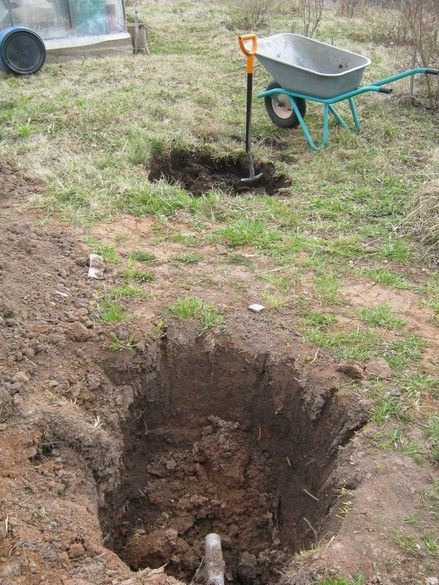
The new well decided to dig up no matter how much sandy soil, I had to pretty deepen. In order to be able to turn around and at least wield a shovel, the pit had to be dug in double width and anyway, throwing out the soil resembled a sort of “form” from Tai Chi. Deepened as much as possible. He did not manage to measure the depth, but barely crawled out. Consistent with growth - a little more than two meters. It turned out as it should according to the charter. I didn’t get to the bottom of pure sand, the soil was still clay, but the proportion of sand increased significantly, this could be judged without a can of water, by less sticking to the shovel and by the characteristic rattle when stuck.
After leveling the bottom, he increased the drain pipe and carried out a control wash. All the water (40 ... 50 l) went into the ground, there was not even a hint of a "puddle".The result was considered quite satisfactory, the temptation to drain water from the kitchen here, was rejected by mature thought. Preferred potential longevity.
It was decided to use the entire area of the open pit, for which the tires were stacked in two rows side by side, in two rows in height. One of the rows was drowned, the second was brought to the surface. A kind of underground cavity was formed with a significant absorption area. The bottom of the pit was covered with a layer of broken slate and fragments of red brick - from temporary stoves and formed during cutting. Slate was also used substandard - in fact it utilized all the “stone” garbage, especially slate - it, unlike other materials, is very inconvenient to use as a bute for concreting - the last refuge for all solid rubbish. He broke large pieces with a hammer - he entrusted this matter to the child, the energy of the atom, so to speak, in a peaceful direction.
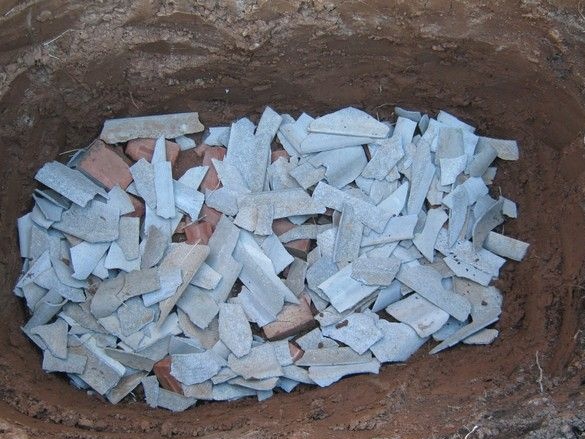
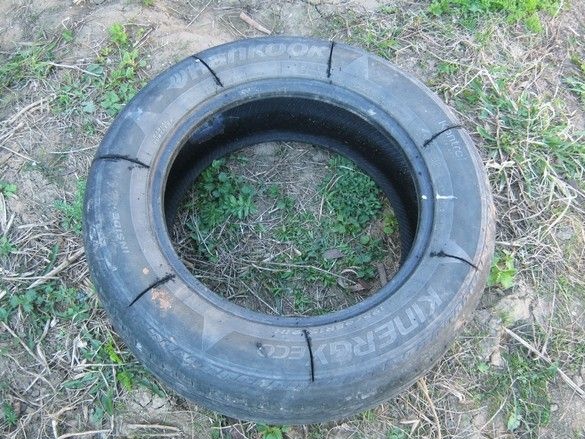
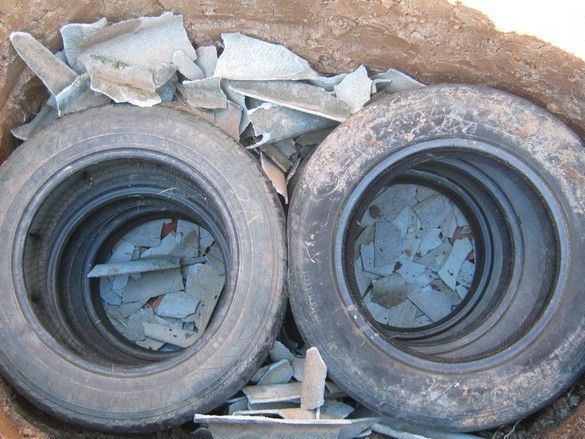
He put tires on slate-brick fragments, previously on the underside of each tire, a “grinder” made several cuts so that water would not stagnate - there would be less smell and mosquitoes. Sawed with an ordinary thin abrasive disc for metal. On the street, standing on the windward side - a lot of smoke. Yes, it’s worth doing it in an old long-sleeved shirt and whatever it is on your head - small sticky rubber particles fly off, it is difficult to wash it off the skin - from the second or third bath.
Empty seats in the pit around the stacks of tires were also clogged-filled with broken slate and brick fragments. Inside a low pile, he filled pieces of bricks so that the soil (pile) lying on top would not flatten it.
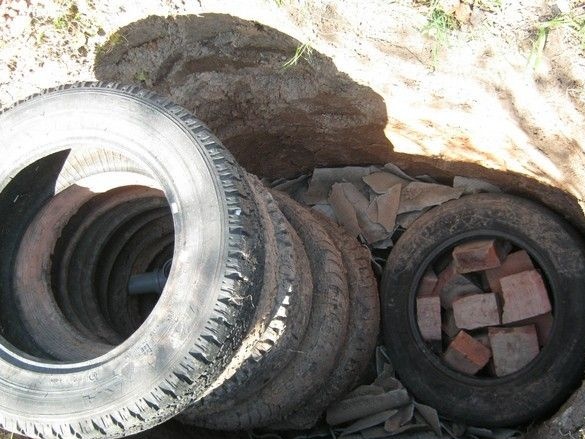
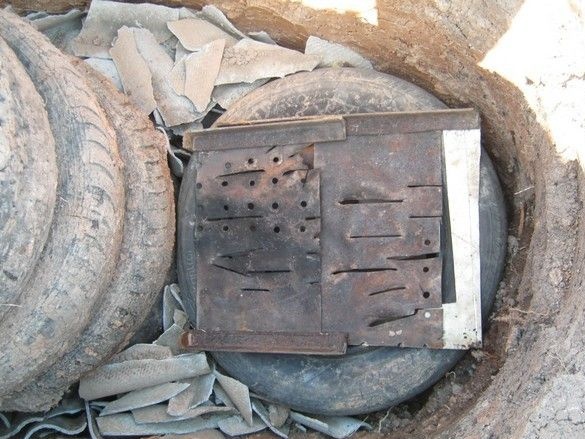
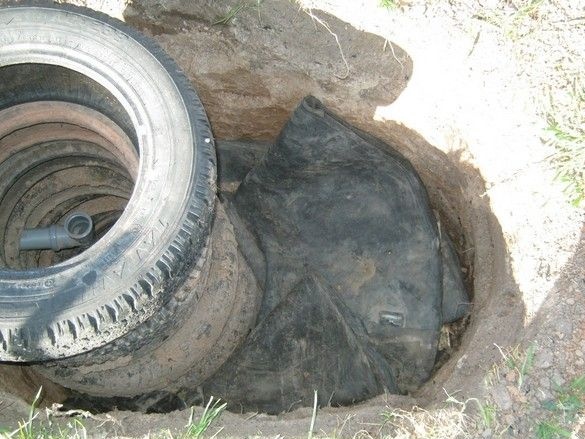
On top of the brick backfill, organized a sort of flat area. I used two pieces of iron from a home-made bath stove - once it was an impromptu grate. Stainless steel glands, but the years of hard life, they were greatly distorted and oxidized. On top of the holey glands, he laid several wallows chambers from tractor wheels. Rubber will not allow soil stuff to wake up inside. There were cameras on the street and the rubber cracked a lot. I cut out several pieces more kissed - for gaskets, the rest in the pit. Utilized with benefit.


Well, gradually heaped up with excavated soil, in small layers, trampling each. A regular tee was docked at the end of the sewer pipe - the drained water flows down, possible clogging is visible from above and is easily eliminated. In the last photo there is a head covered with a piece of Penoplex. In theory, it would be worth putting a few more tires - they will be more visible in the thickets of grass, it will be more convenient to mow this grass with a trimmer with fishing line. In winter, such a head is easier to find under the snow. Top tires, for stability, should be fastened from the inside with galvanized screws.
Total - one household concern became less, during construction, a whole bunch of trash was utilized with benefit.

